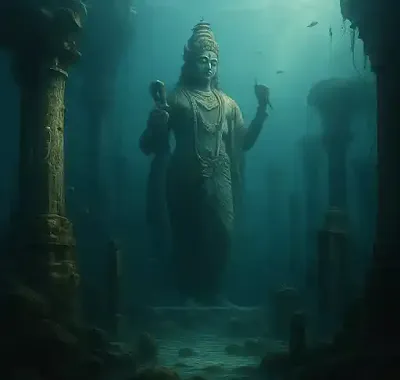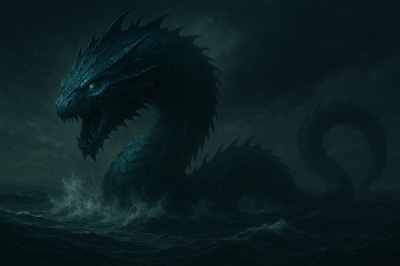Dwarka: The Sunken City of a God
"A city too divine to survive in mortal lands. So, it chose the ocean."
Introduction
Dwarka. A name that whispers through the pages of Indian mythology, vibrating with mystique, divinity, and enigma. Known as the holy city of Lord Krishna, Dwarka has always stood at the edge of reality and legend. While one half of the world dismisses it as a fable from ancient scriptures, the other half has been diving deep into the Arabian Sea, hoping to unearth remnants of an underwater city that once defied the laws of time.
This isn't just a story of gods. It's a story of architecture, war, prosperity, downfall, and a civilization that possibly walked the earth... and then vanished beneath the waves.
What Was Dwarka?
In the sacred texts, Dwarka is described as a kingdom built by none other than Lord Krishna himself. After fleeing Mathura due to constant attacks from Jarasandha, Krishna established a new kingdom far away from danger, on the western coast of India. This city was not ordinary. It was a marvel, described as being made of gold, adorned with precious gems, with massive gates, lush gardens, and wide roads.
The word 'Dwarka' comes from 'Dwar' (door) and 'Ka' (Brahma or moksha), meaning 'Gateway to Salvation.'
When Was Dwarka Built?
While mythological texts trace Dwarka back to around 3000 BCE, archaeological and geological studies point to a city submerged in the Arabian Sea that dates back to approximately 1500–1700 BCE, aligning with the end of the Harappan period.
Marine archaeologists from the National Institute of Oceanography (NIO) found submerged structures off the coast of Gujarat, near present-day Dwarka. These include walls, stone anchors, and grid-like city planning, all hinting at a highly advanced maritime city.
How Many People Lived There?
Historical estimates, although speculative, suggest that Dwarka might have housed over 25,000 inhabitants. These weren’t ordinary settlements. The city had distinct sectors for traders, warriors, artists, sages, and priests. It was a multi-layered urban ecosystem with advanced civic planning — drainage systems, wells, and reservoirs.
Life in a Coastal Wonder
Unlike modern coastal cities that often struggle with nature, Dwarka embraced the sea. It had:
Harbors and docks for trade
Sea routes to Mesopotamia, Egypt, and the Indus Valley
Bridges and causeways connecting islands
Life in Dwarka was a fusion of luxury and spirituality. Temples echoed with mantras while markets buzzed with spices, textiles, and gemstones. The city breathed through its connection with nature, especially the ocean.
What Was the Ecosystem Like?
Dwarka wasn’t just spiritually rich; it was ecologically abundant:
Coral reefs surrounding the coast
Lotus-filled freshwater lakes inside the city
Dense sandalwood groves
Gomti river flowing into the sea
It was a city that thrived without polluting. Krishna ensured nature wasn’t a resource, but a companion.
Was There Treasure?
Oh, absolutely – if legends are to be believed.
Every palace of Krishna was said to be embedded with gems. Floors sparkled with emeralds. Chandeliers made of pearls and gold. Even horses wore silver bridles.
Modern underwater excavations have recovered:
Seals with inscriptions
Anchors from large ships
Sculptures and pottery
But the real treasure — the temple of Krishna, golden chariots, vaults filled with artifacts — remains elusive. Divers believe they are still buried deep under sediment and coral.
How Did Dwarka Sink?
There are two versions:
1. Scientific Theory:
Sudden rise in sea level
A powerful tsunami or earthquake
Coastal erosion over centuries
2. Scriptural Version:
After Krishna's departure, the sea consumed the city
The divine era ended; mankind wasn’t worthy of such a place anymore
The Mahabharata mentions:
> "The moment Krishna left the earth, the ocean surged and swallowed Dwarka, leaving no trace."
Modern-day marine researchers claim satellite and sonar imagery reveals submerged city structures arranged in grid patterns, roads, and fort walls — just like the scriptures said.
What Is the Greatest Mystery?
If Dwarka is real, then Mahabharata isn’t just a myth. That’s the terrifying and exciting possibility.
If Krishna built a city of such scale, what else was real?
The Kurukshetra war?
Flying chariots (Vimanas)?
Divine weapons?
No other city’s discovery has the potential to rewrite ancient human history like Dwarka. And that's what makes it not just an archaeological curiosity but a ticking bomb under modern historical narrative.
What About Dwarka Today?
The present-day city of Dwarka in Gujarat is a pilgrimage town with the Dwarkadhish Temple as its centerpiece. While it’s built on land, legends say it’s just one of the seven layers — each submerged over centuries.
Every year, pilgrims visit not just to worship but to feel a connection to a city that once defied logic.
Tourists can take boat rides, visit the underwater museum being planned, and watch documentaries. But even today, divers return with more questions than answers.
Final Thoughts
Dwarka is not just about Krishna or temples. It's a question mark carved into the ocean floor. It dares us to look deeper — both into history and belief.
Maybe it was real. Maybe it wasn’t. But as long as the ocean hides its secrets, Dwarka will live on — in sonar scans, in legends, in dreams, and in the eternal -
Chase for truth.
So the next time a wave crashes, remember: it might be whispering a story from a kingdom that once ruled the seas.







Comments
Post a Comment